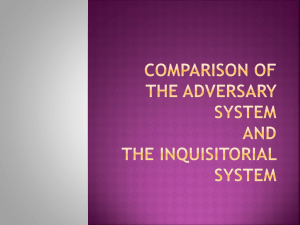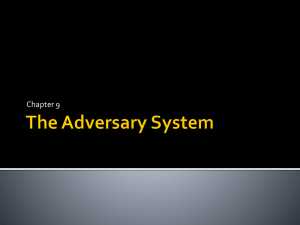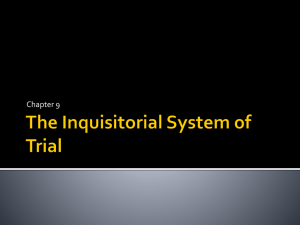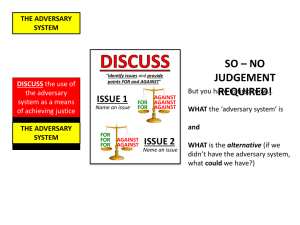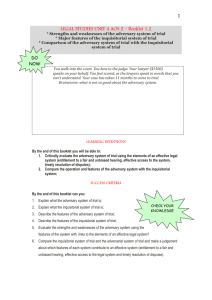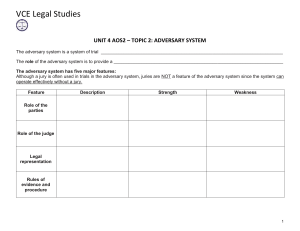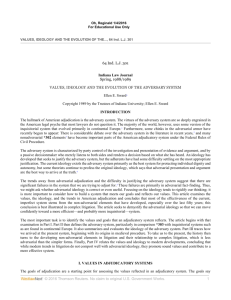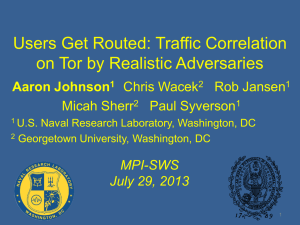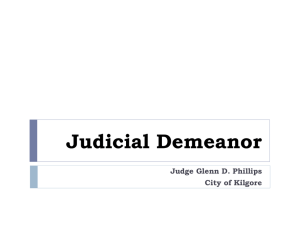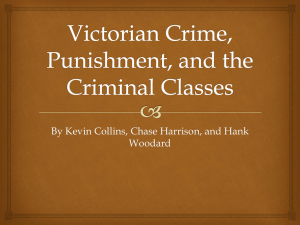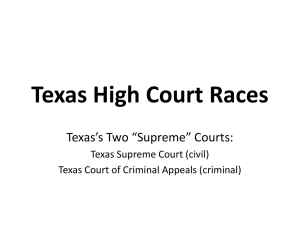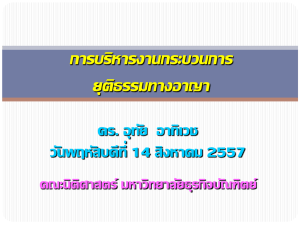AOS 2 Unit 4 - VCE Legal Studies
advertisement
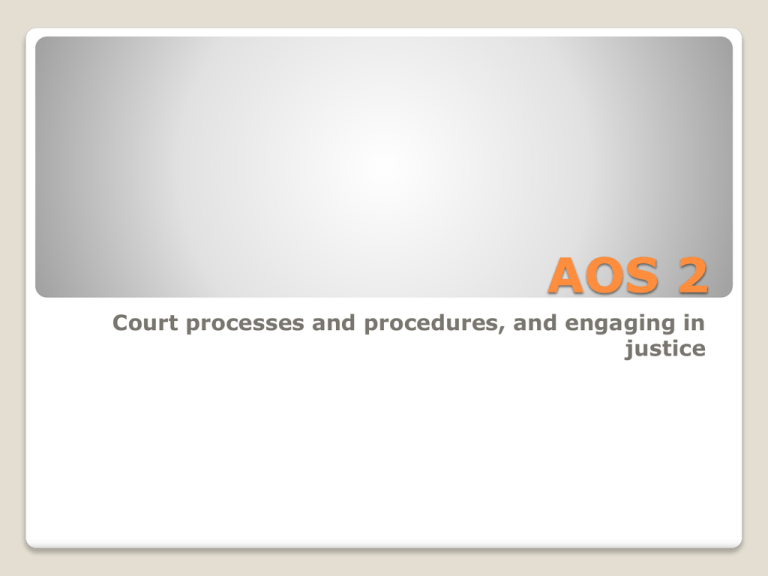
AOS 2 Court processes and procedures, and engaging in justice Dispute resolution through courts operating under the adversary system of trial is characterised by formal processes and procedures that must be adhered to by all parties involved with the case. Students investigate the major features of the adversary system of trial, and aided by a comparison with the inquisitorial system of trial, evaluate the adversarial approach to dispute resolution. They also examine criminal and civil pre-trial and post-trial procedures. Students investigate the role of criminal and civil juries, consider their strengths and weaknesses, and suggest reforms and alternatives applicable to the current jury system. Throughout their investigation of court processes and procedures, students assess the extent to which these processes contribute to an effective legal system. Area of Study 2 On completion of this unit the student should be able to explain the processes and procedures for the resolution of criminal cases and civil disputes, and evaluate their operation and application, and evaluate the effectiveness of the legal system. To achieve this outcome the student will draw on key knowledge and key skills outlined in Area of Study 2. Outcome 2 • the elements of an effective legal system: entitlement to a fair and unbiased hearing, effective access to the legal system and timely resolution of disputes • major features of the adversary system of trial, including the role of the parties, the role of the judge, the need for the rules of evidence and procedure, standard and burden of proof and the need for legal representation • strengths and weaknesses of the adversary system of trial • major features of the inquisitorial system of trial • possible reforms to the adversary system of trial • criminal pre-trial procedures and their purposes, including bail and remand and committal hearings • general purposes of criminal sanctions • an overview of three types of sanctions and their specific purpose • Supreme Court civil pre-trial procedures, including pleadings, discovery and directions hearings, and the purposes of these procedures • the purpose of civil remedies • types of civil remedies, including damages and injunctions • the role of juries, and factors that influence their composition • strengths and weaknesses of the jury system • reforms and alternatives to the jury system • problems and difficulties faced by individuals in using the legal system • recent changes and recommendations for change in the legal system designed to enhance its effective operation. Key knowledge • define key legal terminology and use it appropriately • discuss, interpret and analyse legal information • apply legal principles to relevant cases and issues • critically evaluate the adversary system of trial • compare the operation and features of the adversary system with the inquisitorial system • describe the pre-trial procedures for the resolution of criminal cases and civil disputes, and compare their relative purposes • discuss the ability of criminal sanctions and civil remedies to achieve their purposes • critically evaluate the effectiveness of juries • suggest and discuss reforms and alternatives to the adversary system and the jury system • evaluate the extent to which court processes and procedures contribute to an effective legal system. Key skills The word adversary means opponent or competitor The adversary system of trial is a contest, where the parties fight to win. The adversary system is the system of trial used by most courts in Australia. The adversary system of trial Adversary system of trial is a contest between the parties Two parties Putting opposing arguments to an independent umpire Who will decide which side is in the right and which side is in the wrong The adversary system involves: Key words: ACTIVE and CONTROL Parties have control over how they present their case They decide when to commence proceedings, what evidence to bring, what law to argue, what witnesses to call, and what questions to ask those witnesses Feature No. 1: The role of the parties Parties decide what witnesses to call Strengths of the active role of the parties Weaknesses of the active role of the parties Parties are more likely to feel satisfied with the result if they have control over the case and the way it is presented It is stressful and difficult for parties because the responsibility is on them to seek evidence, laws and witnesses The people who know the situation best are the ones in charge of the proceedings It gives an unfair advantage to repeat offenders (because they know the system) or wealthier parties (because they have the money and resources to hire good lawyers and experts and can afford to appeal) Strengths and weaknesses of this feature of the adversary system Key words: PASSIVE, INDEPENDENT, UNBIASED The judge presides over the court, ensuring the rules of evidence and procedure are followed. If a jury is used, the judge may explain the law to them. The judge listens to the arguments presented by the parties and makes an unbiased decision. Feature No. 2: The role of the judge A judge is meant to be fair and unbiased Strengths of having a passive judge Weaknesses of having a passive judge The judge’s impartiality and lack The judge is unable to assist of bias protect the integrity of the unrepresented, inexperienced or court and the legal system otherwise disadvantaged parties The judge can keep an objective view by not interfering in the contest, therefore they can make a fair decision The judge’s experience and expertise is wasted because they cannot contribute to the case. Strengths and weaknesses of this feature Keywords: STRICT, COMPLEX Rules of evidence govern what evidence is admissible and inadmissible. Rules of procedure govern how the trial is run. Feature No.3: The rules of evidence & procedure Strengths of rules of evidence & procedure Weaknesses of rules of evidence & procedure Strict rules of evidence make sure that all evidence presented in court is relevant, reliable and legally obtained Some important evidence can be excluded on a technicality Strict rules of procedure ensure a Strict and complex rules make it smooth trial and put parties on difficult and stressful for parties an equal footing to present their case – it can also add to the amount of time and expense of the case Strengths and weaknesses of this feature Keywords: PERSON BRINGING THE ACTION, HIGH LEVEL The burden of proof is on the plaintiff or the prosecution. They bring the action and so have the responsibility to prove it. The standard of proof is the amount of proof required: on the balance of probabilities (civil) or beyond reasonable doubt (criminal) Feature No. 4: The burden & standard of proof The burden of proof is on the plaintiff or prosecution Strengths of the burden & standard of proof Weaknesses of the burden & standard of proof They ensure unfounded claims do The party that has been wronged not succeed has total responsibility to prove the case They protect the presumption of innocence This adds further stress and cost for the parties having to provide the proff Strengths and weaknesses of this feature Keywords: HIGH NEED, NECESSARY FOR SUCCESS Because of the other features of the adversary system, legal representation is vital is gaining a proper chance of success Feature No. 5: The need for legal representation Solicitors and barristers are necessary for success Strengths of legal representation Weaknesses of legal representation A confident, experienced and trained professional can put the case as efficiently and persuasively as possible Good representation is too expensive for most people to afford Lawyers take the pressure off the The cost of barristers can give parties, which is better for wealthier parties an unfair disadvantaged and inexperienced chance of success parties Strengths and weaknesses of this feature The Inquisitorial System A method of legal practice in which the judge endeavors to discover facts while simultaneously representing the interests of the state in a trial. It is the system used in many civil law countries (as opposed to common law) such as France and Spain, and some Australian courts such as the Family Court and Coroners Court. Definition of inquisitorial system A trained professional Investigates both sides of a matter And has access to all the information about it Features of the inquisitorial system So the truth will be discovered Unlike the adversary system, the inquisitorial system is not a contest but more like an investigation Keywords: INACTIVE, PASSIVE Parties observe proceedings and can have input via statements and making requests of the judges, but they do not control proceedings or evidence Strength: The burden is taken off parties, so it is less stressful and expensive for them Weakness: Parties may feel at the mercy of the judges, and therefore less satisfied with the decision Comparison with adversary: role of the parties Keywords: IN CONTROL, INVESTIGATORY The judge (or panel of judges) exercises almost complete control over the case. They collect and examine evidence, choose which witnesses to hear from, and decide both the relevant law and the facts Strength: The judge’s expertise is used and parties are not able to hide or manipulate unfavourable evidence Weakness: The judge may lose some of their impartiality, being so involved in the investigation. Also, the judge does not have to investigate angles the parties think are important Comparison with adversary: role of the judge Keywords: FLEXIBLE, LOOSE Rules of evidence are almost non-existent: hearsay, prior convictions and written evidence are all allowed. Rules of procedure are not necessary, as the judge conducts proceedings. Strength: Parties do not have to navigate complex and stressful procedures. All relevant evidence is taken into account. Weakness: Evidence such as prior convictions may be unfairly prejudicial to the defendant. Documentary and hearsay evidence cannot be tested thoroughly. Comparison with adversary: rules of evidence & procedure Keywords: ABSENT BURDEN, HIGH STANDARD There is no formal burden of proof, as the judge investigates both sides of the case simultaneously. There must still be significant evidence to show that the defendant was at fault. Strength: The injured party does not need to bear the burden of conducting the case. Unfounded criminal or civil claims should still not succeed. Weakness: Because the defence’s case is examined before fault has been proved, the idea that the defendant is innocent until proven guilty is not felt strongly. Comparison with adversary: burden and standard of proof Keywords: SUPPORTIVE ROLE, NOT NECESSARY Legal representatives support the parties, explain proceedings to them and can make requests of the judge. They may also assist the judge with investigating the case. Strength: A party’s success does not rely on their legal representation, so it decreases costs and doesn’t benefit wealthier parties as much. Weakness: Parties cannot choose the person they trust the most to argue for them and give them the best chance of success. Comparison with adversary: need for legal representation Which one is better? Adversary system or inquisitorial system? Criteria for an effective legal system Reform Benefits Give the judge a more investigative role by allowing them to question witnesses and gather evidence Unrepresented parties could be assisted and the judge’s expertise would be utilised. It is more likely that all evidence would be uncovered. Relax the rules of evidence to allow documentary evidence and some currently inadmissible evidence Flexible rules would be easier to navigate and less stressful for parties. A more complete picture of events would emerge. Recent reforms to the adversary system adopted aspects of the inquisitorial system

